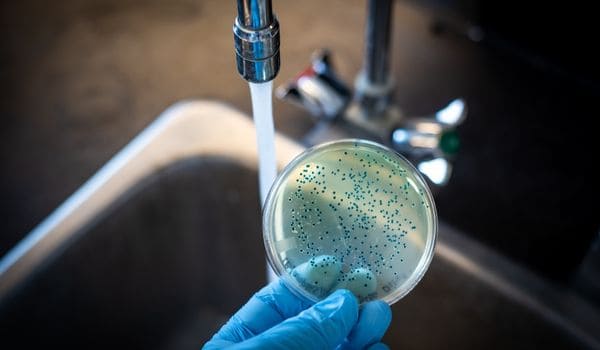Ultrafiltration might sound like something out of a lab — but it’s becoming a go-to option for cleaner water at home. From under-sink systems to advanced pre-filters, UF membranes remove a surprising amount of junk from your tap — all without electricity or chemicals.
But how does it actually work? And how does it stack up next to an RO or carbon filters?
Let’s break it down.
✅ Key Takeaways
- 🧪 UF (Ultrafiltration) uses a membrane with tiny pores (0.01–0.1 microns) to physically block bacteria, parasites, and sediment.
- 🚱 Does not remove dissolved minerals, VOCs, or chemicals — so it’s best used with carbon filters or as a pre-treatment.
- ⚡ No electricity or tank needed — great for on-demand filtration with low waste.
- 🧼 Ideal for removing: bacteria like E. coli, Giardia, Cryptosporidium, and cloudy water caused by fine particles.
- 🛠️ Used in: homes, hospitals, aquariums, food prep, and as a pre-filter for reverse osmosis systems.
⚙️ How It Works

Ultrafiltration (UF) is a pressure-driven membrane filtration process. It works by forcing water through a semi-permeable membrane with tiny pores — small enough to block bacteria, viruses, and suspended solids, but large enough to let water and some dissolved molecules pass through.
Think of it as a super-fine strainer that only allows pure H₂O and very small solutes to get through.
✅ How It Filters:
- Pore size: Typically 0.01 to 0.1 microns
- Blocks: Bacteria, protozoa, fine sediment, and some larger viruses
- Allows: Water, salts, and most dissolved organics
- Powered by: Household water pressure — no electricity required
💡 Good to Know:
UF doesn’t remove dissolved minerals, salts, or VOCs on its own — that’s where carbon or RO filters come in. But as a first-stage or standalone system, it’s excellent for removing particles and microorganisms.
| 🧪 Removed by UF | 🚫 Not Removed by UF |
|---|---|
| Bacteria (e.g., E. coli) | Dissolved salts (e.g., sodium, chloride) |
| Protozoa (e.g., Giardia, Cryptosporidium) | Volatile Organic Compounds (VOCs) |
| Most viruses (larger than 0.01 micron) | Heavy metals (e.g., lead, arsenic) |
| Fine sediment, clay, silt, rust | Fluoride and nitrates |
| Suspended organic particles | Chlorine or chloramine |
💧 Why UF Works So Well

🌀 Where UF Systems Work Best
Ultrafiltration isn’t just for labs anymore — these systems are showing up in everything from kitchen sinks to municipal water plants. So where does UF really excel? Let’s break it down.
💧 Common Uses for Ultrafiltration:
- 🏠 Drinking Water Purification: UF removes bacteria, cysts, and fine sediment without stripping away healthy minerals — making it ideal for clean, mineral-balanced tap water.
- 🏭 Wastewater Treatment: Industries use UF systems to clean up wastewater before discharge or reuse, thanks to their ability to handle high loads of solids and microbes.
- 🔁 RO Pre-Treatment: UF is often installed ahead of reverse osmosis systems to prevent membrane fouling and extend system life.
- 🧪 Lab & Medical Applications: UF membranes offer sterile filtration for lab processes, pharmaceuticals, and even home medical devices like CPAPs.
Ultrafiltration shines in situations where you want clean, safe water — without the bulk, waste, or mineral loss of other systems. Whether it’s your kitchen sink or a full-scale treatment plant, UF is a reliable, low-maintenance option that punches well above its weight.
🤔 UF vs. NF: What’s the Difference?

Ultrafiltration and nanofiltration both use membranes to filter water, but they target different types of contaminants. Not sure which one is right for your setup? Here’s a side-by-side look at what each system does best — and where they might fall short.
| Ultrafiltration (UF) | Nanofiltration (NF) | |
|---|---|---|
| 👍 Pros | ✅ Retains healthy minerals ✅ Lower upfront and operating costs ✅ Minimal water waste ✅ Smaller footprint and easier to install |
✅ Removes smaller contaminants (e.g. some salts, organics) ✅ Better at softening water ✅ Higher level of purification than UF |
| 👎 Cons | ⚠️ Doesn’t remove dissolved salts or smaller organics ⚠️ Not effective against some viruses without pre/post-treatment |
⚠️ Removes beneficial minerals ⚠️ Produces more wastewater than UF ⚠️ Slightly higher energy requirements |
💡 Good to Know:
If your main goal is to improve water taste and remove bacteria or sediment, UF is often more than enough — especially if your water has already been treated. But if you’re dealing with stubborn contaminants or hard water minerals, NF might offer that extra edge. Just remember: more filtration doesn’t always mean better — it’s about matching the system to your water.
🧪 Real-World Uses of UF

🧪 Ultrafiltration in Water Treatment: Real-World Uses
Ultrafiltration isn’t just some high-tech lab experiment — it’s actually showing up in a lot of places you’d never expect. From household filters to citywide treatment plants — UF has become a reliable way to clean up water without relying on heavy chemicals.
Its strength? It’s versatile. Whether you’re dealing with muddy well water or prepping water for industrial reuse, ultrafiltration quietly gets the job done.
✅ Common Places You’ll Find UF Technology:
- Drinking Water Systems – Makes water safer by filtering out bacteria and gunk you don’t want in your glass.
- Wastewater Plants – Helps clean up industrial and municipal wastewater before it’s released (or reused).
- RO Pre-Filtration – Acts like a bodyguard for osmosis membranes, catching particles before they cause problems.
- Food & Beverage Production – Keeps water consistent during brewing, bottling, or mixing.
💡 Pro Tip:
If you’re adding a RO system to sediment-heavy water, consider pairing it with a UF stage. It’s a smart way to protect the RO membrane and improve efficiency long-term.
✅ UF vs. RO: Key Differences

Ultrafiltration (UF) and reverse osmosis (RO) both use membrane technology, but the way they work — and what they remove — is quite different. Here’s how to compare them at a glance:
| 🔍 Feature | ⚡ Ultrafiltration (UF) | 💧 Reverse Osmosis (RO) |
|---|---|---|
| Contaminants Removed | Suspended solids, bacteria, some viruses | Dissolved salts, heavy metals, bacteria, VOCs |
| Pore Size | 0.01 – 0.1 microns | 0.0001 microns |
| Water Pressure Needed | Lower | Higher (may need a booster pump) |
| Wastewater Produced | Minimal | 2–3 gallons per gallon purified |
| Taste | Retains natural minerals | Flat (can be remineralized) |
| Common Use | Whole-house, well water, pre-filters | Undersink drinking water filters |
| Maintenance | Membrane replacement | Multiple filters + tank care |
| Cost | Lower upfront & upkeep | Higher upfront + membrane/filter costs |
💡 Good to Know:
If you’re filtering well water or want to protect a more complex RO system, UF can be the perfect first line of defense. It’s budget-friendly, fast-flowing, and easy to maintain — but if you need to tackle dissolved solids or lead, RO still wins.
🧠 UF or RO — Which One’s Right for You?

Choosing between ultrafiltration and reverse osmosis really comes down to your water quality, household needs, and what you value most — whether it’s mineral retention, contaminant removal, or overall convenience.
✅ Go with Ultrafiltration if you want:
- Fast-flowing filtered water for the whole house
- To preserve healthy minerals in your water
- Minimal wastewater and lower environmental impact
- Easy maintenance and a lower upfront investment
- A reliable pre-filter for sediment, bacteria, and organics
✅ Go with RO if you need:
- Maximum removal of dissolved solids like lead, fluoride, or nitrates
- Ultra-purified water for drinking and cooking
- Protection against VOCs and hard-to-remove contaminants
- A long-term solution for serious water quality concerns
- The option to remineralize for taste and health
💡 Pro Tip:
If you want the best of both worlds, some systems combine UF with RO — using ultrafiltration to extend the life of the RO membrane while giving you complete coverage from sediments and dissolved pollutants.
✅ Final Thoughts
Ultrafiltration isn’t just a buzzword — it’s a powerful filtration method that bridges the gap between simple sediment filters and complex systems like and RO system.
Whether you’re dealing with cloudy water, bacteria, or just want cleaner tap water without stripping away natural minerals, UF offers an efficient and eco-friendly solution. It’s compact, low-maintenance — and versatile enough for everything from: whole-house systems to under-sink installs.
And while it won’t remove every dissolved contaminant, pairing it with activated carbon or RO filtration can take your water quality to the next level.
💡 Good to Know:
Still unsure whether UF is right for you? Start with a water test — once you know what you’re dealing with, you can choose the system that solves the actual problem (not just what sounds good on a label).
 95 people found this helpful. Was this guide helpful to you?
95 people found this helpful. Was this guide helpful to you? 

